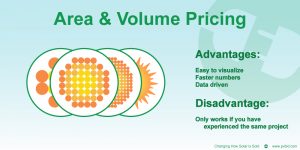 There is definitely more to estimating than Unit pricing and Take-offs! They have a time and a place. I typically draw on them when I have to bid something about which I have no context or experience. Imagine the people who bid on STS-1 (the first space shuttle ever built), for instance. They had very little to draw on to guide their bids, just some blueprints. So they had to add up all the parts and actions: a true take-off. As an aside, I believe the STS-1 was actually built by NASA mostly, but you get the point. Area or volume pricing, however, can be a really great way to handle things when you have some data already.
There is definitely more to estimating than Unit pricing and Take-offs! They have a time and a place. I typically draw on them when I have to bid something about which I have no context or experience. Imagine the people who bid on STS-1 (the first space shuttle ever built), for instance. They had very little to draw on to guide their bids, just some blueprints. So they had to add up all the parts and actions: a true take-off. As an aside, I believe the STS-1 was actually built by NASA mostly, but you get the point. Area or volume pricing, however, can be a really great way to handle things when you have some data already.
Next on the estimating list: Averages. Really an extension of the Unit pricing, averages draw on databases of information. With this method, you tally up all the information you have for something and then divide it by a physical dimension. Cost per watt is a great example of this technique. I’m sure you’ve noticed the solar industry sometimes gets locked into a price per watt as a way to describe a system cost.
Sub-techniques such as Area or Volume pricing fall under averages. R.S. Means is probably the most used and most quoted Area or Volume pricing database that is purchasable. The databases have lists of common things that you then multiply by your dimensions. General contractors use this a lot. Have you ever heard of someone saying that a house costs $78 per square foot? That’s them drawing on their own data, or maybe the US Census data for new house costs.
How You can Use This Information
“Great” you say, “but how does this help me with solar?” I’m glad you asked! Unfortunately for the solar industry, not much solar-specific information exists in the nationally available databases. Time has found solar actually being added to R.S. Means. It is in the form of cost per square foot and cost per watt. I suspect in a few more years a lot more will be available. For solar in particular, I like to use other average numbers like cost per square foot and cost per module. We will talk about those and other approaches in future blog entries!

